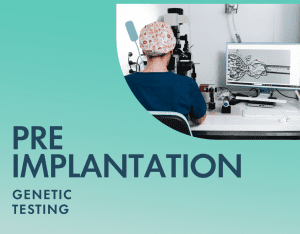
Two Embryolab specialists
- Dimitris Michalakis, MD, MSc, Reproductive Gynecologist
- Chara Oreopoulou, B.Sc., M.Res., Senior Clinical Embryologist (ESHRE Cert.)
provide information on Preimplantation Genetic Testing (PGT) and answer your questions:
Who is PGT recommended for? What is it and how is it done? What are the results? Does it increase the success rate of IVF?
At Embryolab, we have been applying the most modern methods of assisted reproduction for 20 years.
Tip!
√ 1 in 2 carriers of a genetic disease will have a healthy child with the innovative method of Preimplantation Genetic Diagnosis (PGT), a genetic test performed on day-5 embryos.
Who is preimplantation testing recommended for?
Preimplantation testing is a diagnostic test, an important tool in the field of assisted reproduction, as it allows the identification of embryos with normal structure and number of chromosomes (PGT-A, PGT-SR), as well as those that do not carry specific monogenic diseases (PGT-M).
According to the current legislation in Greece, in order to allow embryo testing with preimplantation genetic testing, certain conditions must be met.
More specifically, for PGT-A (Preimplantation Genetic Testing for Aneuploidies), the presence of at least one of the following criteria is required:
1. Woman over 40 years of age who is going to use her own eggs.
2. History of at least two first-trimester miscarriages of unknown cause.
3. History of at least three failed IVF attempts.
4. Chromosomal abnormalities in the karyotype of at least one of the couple’s members.
Regarding Preimplantation Testing for Structural Chromosome Rearrangements (PGT-SR), it is applied in cases where one of the two in the couple carries chromosomal variations in the karyotype, which may lead to the creation of embryos with an abnormality in the structure or number of chromosomes. Examples of structural abnormalities in the couple are the following:
1. Reciprocal and balanced translocation.
2. Robertsonian translocation.
3. Pericentric inversion.
4. Deletions or duplications.
5. Numerical abnormalities of the sex chromosomes (Klinefelter syndrome, Turner syndrome).
Preimplantation Genetic Testing for Monogenic Diseases is required when one or both parents carry mutations of monogenic diseases that can be inherited by offspring and are associated with a serious impact on their quality of life. Examples include:
• Prospective parents who are both carriers of recessive monogenic diseases such as cystic fibrosis, Mediterranean anemia, sickle cell anemia, etc.
• Prospective parents where one of the two is a carrier of a monogenic disease that is inherited in a dominant manner.
• Sex-linked monogenic diseases such as hemophilia, muscular dystrophy, etc.
• Inherited cancer such as mutations in the BRCA 1, 2 genes.
What is it and how is it done?
Preimplantation genetic testing (PGT) is currently the main diagnostic tool for identifying genetic abnormalities in embryos and is divided into three categories:
a) testing for aneuploidies (PGT-A)
b) testing for monogenic diseases (PGT-M)
c) testing for chromosomal structural rearrangements (PGT-SR).
It is now possible to perform two categories of preimplantation testing simultaneously, depending on the history and needs of each case.
The process involves culturing the embryos until the blastocyst stage (5th to 6th day of development) and requires the blastocysts to have reached a suitable size so that their biopsy can be performed safely. During the biopsy, a piece of the trophectoderm of the embryo (4-8 cells) is removed with the help of a special laser, which is passed through a “washing” process in a special liquid and placed in a tube to be sent to the genetics laboratory. Finally, the blastocysts are cryopreserved by vitrification and marked with a unique code so that they can be matched with the result of their genetic analysis.
What are the results?
With the results of the genetic analysis, an embryo can be characterized as:
Euploid: The correct number of chromosomes is found, so the embryo is suitable for embryo transfer.
Aneuploid: A lack or excess of genetic material is found, so embryo transfer is not recommended.
Mosaic: A lack or excess of genetic material is found, but in some of the cells sent for analysis, while the correct number of chromosomes is found in the remaining cells. In these cases, the type and percentage of mosaicism is taken into account and, after genetic counseling, the suitability or not of the embryo for embryo transfer is decided.
In cases where the test concerns a monogenic disease (PGT-M), such as Mediterranean anemia, it is reported whether one (carrier embryo), two (pathological embryo) or none (normal embryo) of the pathological genes are found.
In a small percentage, it is possible that no result can be obtained for an embryo, which lies in the limitations of the technique.
In case of pregnancy with an embryo that has been tested with PGT, it is always recommended to confirm the results through prenatal testing.
Does Preimplantation Testing increase the success rate of IVF?
One of the most frequent questions from our patients is whether Preimplantation Genetic Testing for Aneuploidies increases the success rate of IVF. It is very important to clarify the use and reason for the application of preimplantation testing.
This is a test that is performed on embryos that reach the blastocyst stage and aims to identify embryos with a normal chromosomal profile so that in a future embryo transfer of a euploid embryo we can achieve maximum implantation rates of the blastocyst, the normal development of pregnancy and the birth of a healthy child.
Preimplantation testing is not what will determine IVF success. However, it will diagnose embryos with a normal chromosomal profile from embryos with chromosomal abnormalities. This avoids implantation failures and miscarriages during pregnancy. It is, therefore, a very important diagnostic tool that allows us to select and transfer only euploid embryos from a set of embryos that have reached the blastocyst stage.





